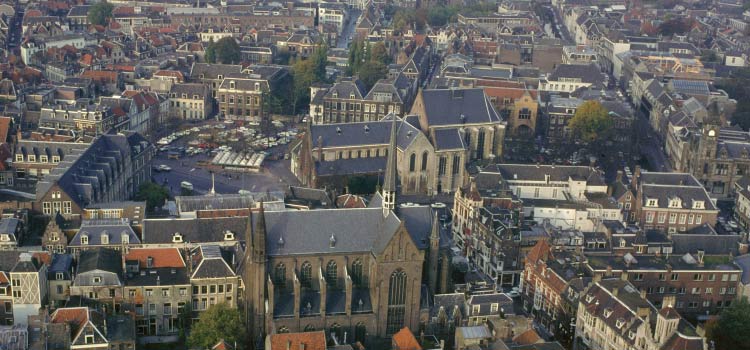
HuizenaanhetJanskerkhof.nl is a Dutch-language website dedicated to the history of the Janskerkhof, a city square in the centre of Utrecht, the Netherlands. Utrecht, the country’s fourth-largest city, lies in the heart of the Netherlands and is famous for its canals with their wharves and wharf cellars. With more than 350,000 inhabitants, the historic city is an increasingly popular tourist destination.
The Janskerkhof (best known for its Saturday flower market) is located in the university district, just 350 metres north of St Martin’s Cathedral and a four-minute walk from Utrecht’s main landmark, the Dom Tower.
Middle Ages
The website focuses on Utrecht’s history, particularly the development and residential history of the Janskerkhof, once a medieval immunity.
The name Janskerkhof, Dutch for “Saint John’s graveyard”, dates back to the foundation of Saint John’s Church (Janskerk) around 1050. Dedicated to John the Baptist, the church was founded by Bishop Bernold.
Ecclesiastical immunity
In the Middle Ages, the Janskerkhof was an ecclesiastical immunity: a walled area around St John’s Church, which served as a collegiate church. An immunity was a sacred place with its own jurisdiction, beyond the authority of city officials.
The members of the chapter of St John were canons, whose lives differed greatly from those of monks. They took no vows of poverty and did not live in monasteries. Instead, they built their own houses with large gardens surrounding the church. Some of these houses still survive.
Canons’ houses could not be rented, mortgaged or sold without the chapter’s consent. Initially inhabited only by canons (who could also be members of other chapters in the city), the houses later attracted wealthy citizens. However, citizens could only be licensed to live in them, as ownership always remained registered under a canon’s name.
Franciscan monastery
In 1246, the chapter of Saint John sold part of its land in the southwest of the Janskerkhof to the Order of the Friars Minor. The Franciscans built a monastery and a church on the site.
Archaeologists recently discovered two medieval crypts during construction work, containing the skeletal remains of seven people, including an unborn child. These remains most likely belonged to wealthy citizens. The mendicant order permitted anyone who wished to be buried in their church.
Brotherhood of Jerusalem Pilgrims
In 1544, the chapter of Saint John donated its chapel on the south side of the Janskerkhof to the Utrecht Brotherhood of Jerusalem Pilgrims. The chapel was renamed the Jerusalem Chapel or Palmites Temple.

A painting by the Dutch master Jan van Scorel, depicting five members of the Brotherhood, once hung in this chapel until its demolition in 1581. Today, the painting is part of the collection of the Centraal Museum Utrecht. The location of the former temple is marked by pavement contours near the bookshop.
After the Reformation
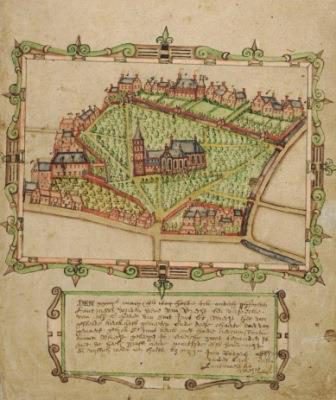
In 1580, Utrecht joined the Reformation, and public Catholic worship was banned. As a result, the Sint-Janskerk ceased functioning as a collegiate church.
The immunity was lifted in 1581, and the walls, the Franciscan church, and the Jerusalem Chapel were demolished. The refectory of the Franciscan monastery later became the Chamber of the States of Utrecht.
St John’s Church
From 1584, the choir of St John’s Church served as the city library, filled with books seized from monastic libraries. From 1585 to 1656, the church was used by the Protestant Walloon Church, and in 1657 it became part of the Dutch Reformed Church. The chapter of Saint John continued to exist, but its new canons were members of the Reformed Church.
Hendrick Goudt and Jacob van Eyck
In 1613, Dutch engraver and painter Hendrick Goudt (1583-1648) purchased one of the canon houses, which still survives today. Around this time, the Janskerkhof developed into a leafy city park filled with lime and elm trees, becoming a favourite spot for young couples.
In 1632, the composer Jacob van Eyck was appointed carillonneur of St John’s Church. In the evenings, he often played his recorder in the park for those out walking. Many of the melodies he performed were later published in his collection Der Fluyten Lust-hof (“The Flute’s Pleasure Garden”) – a fitting name for the Janskerkhof itself.
Utrecht University Library
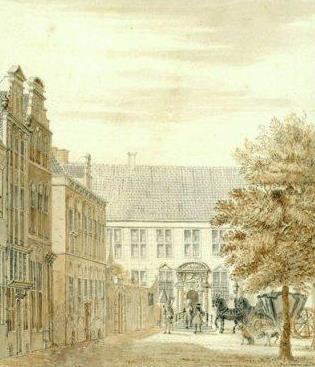
When Utrecht University was founded in 1636, the city library in St John’s Church became the university’s library. By the late 17th century, many of the large gardens on the north side of the square had been replaced by elegant mansions. In 1682, the west facade of St John’s Church received a Baroque redesign, the outline of which is still visible in the pavement today.
Treaty of Utrecht
On 11 April 1713, the Treaty of Utrecht was signed at the Utrecht city hall. During the negotiations, , which began in January 1712, Utrecht hosted a large number of foreign visitors. The envoys from Savoy (Italy), Lorraine (France), Münster (Germany), Hanover (Germany), Trier (Germany), Poland, and Saxony (Germany) rented houses in the Janskerkhof to stay during the congress.
In 1790, the chapter relinquished ownership of the trees and pavements, though it retained the land until the abolition of the chapters by Napoleon in 1811. In 1820, the university library moved to the former palace of King Louis Napoleon on Wittevrouwenstraat.
Modern Times
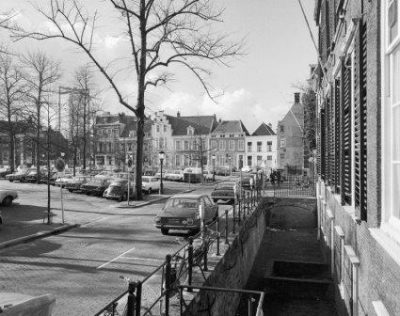
Several canon houses survive, though most of the buildings on the north side of the square date from the Dutch Golden Age and were built for Utrecht’s wealthy elite. Today, many of these mansions serve as university offices, hotels, restaurants or bars, giving the square a lively nightlife.
Today, these mansions are used as office buildings, for university purposes, or as a hotel, restaurant or bar (the Janskerkhof has a vibrant nightlife).
The former Franciscan monastery is now part of Utrecht University, and its refectory is used as a lecture hall. The area is known today as the University District, home to student associations, student residences and nightlife venues.
Flower market
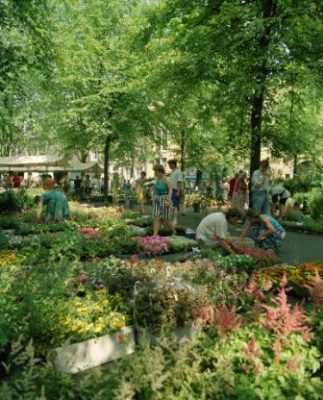
Although the Janskerkhof is no longer a city park and is now partly used for car parking, it retains its rows of lime trees. Every Saturday, the square transforms into a colourful flower market, a tradition dating back to the 1830s.
The Janskerkhof flower market, the largest flower and plant market in Utrecht, is a favourite among both locals and visitors. Stalls sell cut flowers, potted plants, bulbs and garden greenery, making it a highlight of the city’s market tradition.
A Place Worth Visiting
By knowing something of its rich history, visitors can better appreciate the Janskerkhof, one of Utrecht’s most historic squares. When you visit Utrecht, take a walk through the Janskerkhof. If you listen closely, you might even imagine Jacob van Eyck’s recorder echoing through the trees.
Gepubliceerd: 16-03-2016 door Caroline Pelser. Laatst geactualiseerd op 28-08-2025.